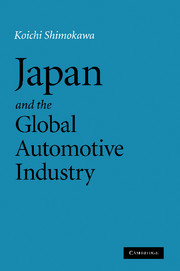Book contents
- Frontmatter
- Contents
- List of figures
- List of tables
- Preface
- Introduction
- 1 Comparing productivity of the Japanese and US automobile industries
- 2 The internationalization of the Japanese automotive industry and local production overseas
- 3 The recovery of European and US auto makers, and relocating and changing lean production
- 4 Early 1990s – the Japanese automotive industry loses international competitiveness, and the development of restructuring strategies
- 5 The restructuring of the global automotive and auto-parts industries
- 6 The restructuring of the world's auto-parts industry and the transfiguration of the keiretsu parts transaction
- 7 Global M&A and the future of the global auto industry – the light and dark sides of merger and re-alignment
- 8 The Asian and ASEAN automotive industries in the global era
- 9 China's automotive industry in the global era, Japanese auto makers, and their China strategies
- 10 Conclusion – the global automotive industry's perspective on the twenty-first century and tasks for the Japanese automotive industry
- Epilogue
- Index
- References
2 - The internationalization of the Japanese automotive industry and local production overseas
Published online by Cambridge University Press: 06 July 2010
- Frontmatter
- Contents
- List of figures
- List of tables
- Preface
- Introduction
- 1 Comparing productivity of the Japanese and US automobile industries
- 2 The internationalization of the Japanese automotive industry and local production overseas
- 3 The recovery of European and US auto makers, and relocating and changing lean production
- 4 Early 1990s – the Japanese automotive industry loses international competitiveness, and the development of restructuring strategies
- 5 The restructuring of the global automotive and auto-parts industries
- 6 The restructuring of the world's auto-parts industry and the transfiguration of the keiretsu parts transaction
- 7 Global M&A and the future of the global auto industry – the light and dark sides of merger and re-alignment
- 8 The Asian and ASEAN automotive industries in the global era
- 9 China's automotive industry in the global era, Japanese auto makers, and their China strategies
- 10 Conclusion – the global automotive industry's perspective on the twenty-first century and tasks for the Japanese automotive industry
- Epilogue
- Index
- References
Summary
The “new” global imperative for the Japanese automobile industry
The Japanese automobile industry has reached a major strategic turning point. Following the collapse of the bubble economy in 1991, the Japanese domestic automobile market experienced a protracted three-year sales slump and underwent major structural changes. This forced the industry to come up with a new strategic response through restructuring and rationalization. Hard hit by the so-called Heisei recession that followed the collapse of the bubble economy, each of the major Japanese auto makers saw a dramatic worsening of its financial results, to the extent that one wonders what has happened to the competitive strength of the world's most powerful global competitors.
The contrast is striking: during the peak years of the 1980s through to 1991, when the companies' operating results were substantially stronger, the eleven auto manufacturers generated profits in a single year of around ¥1.1 trillion, but within a few years profits had fallen to less than half that, at about ¥500 billion, with three of the eleven firms reporting a loss and several others only borderline profitable.
Until this recession, the Japanese industry had generally experienced nearly constant growth, showing a rising curve of sales, volume, and profits. The only times when the industry experienced a decline in production was in 1973, as a result of the first oil crisis, and again in 1981, as a result of the second oil shock and the imposition of voluntary export restraints to the United States.
- Type
- Chapter
- Information
- Japan and the Global Automotive Industry , pp. 57 - 82Publisher: Cambridge University PressPrint publication year: 2010
References
- 1
- Cited by



